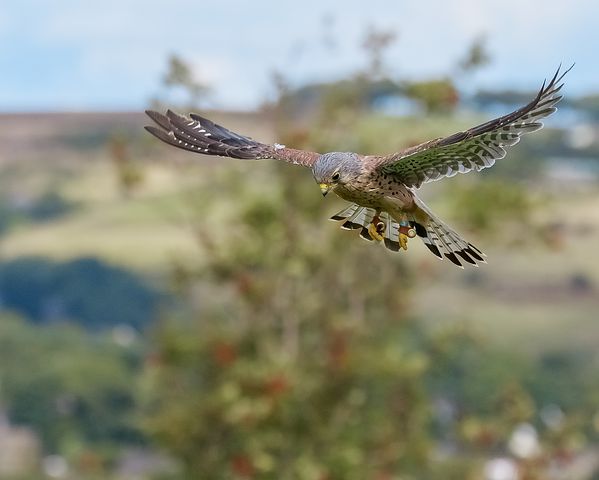
The Windhover is a poem by Gerard Manley Hopkins that represents the awe of the poet on seeing the beauty of God’s creations. The poet sees the falcon as an expression of God’s splendor and love. This poem is structured as an Italian sonnet, made up of an octave and a sestet. The first 8 lines, the octave, have the rhyme scheme ABBAABBA. The sestet is split into two tercets, with the rhyme scheme CDC DCD.
The Windhover | Summary and Analysis
The Windhover is the titular character of this poem. A windhover is a kestrel, that is, a small falcon. The noteworthiness of this falcon is that it is capable of hovering in mid-air while searching for its prey. It suspends itself in a single spot while beating its wings, and swoops down to catch its prey.
The subtitle of this poem is “To Christ Our Lord”. This implies that the poet is speaking directly to God or Jesus Christ. It also shows the reader that the poem is written with a religious undercurrent and is not to be taken only literally.
The Windhover | Analysis, Lines 1-8
I caught this morning morning’s minion, king-
dom of daylight’s dauphin, dapple-dawn-drawn Falcon, in his riding
Of the rolling level underneath him steady air, and striding
High there, how he rung upon the rein of a wimpling wing
In his ecstasy! then off, off forth on swing,
As a skate’s heel sweeps smooth on a bow-bend: the hurl and gliding
Rebuffed the big wind. My heart in hiding
Stirred for a bird, – the achieve of, the mastery of the thing!
The poet felt lucky to have seen the gorgeous falcon stationary in the air, searching intently and gracefully, before swooping off in the ecstasy of finding its prey. The bird is strong and flew against the wind, and its mastery of flight filled the poet’s heart with emotion.
This stanza is very descriptive and tells us how the poet sees the falcon. The bird is described as a servant of the morning, and immediately also referred to as prince (dauphin). This is also a description of Jesus, the Son of God. The bird is steady, and graceful, and remains level in the air even as the winds blow. Its wings are its strength and help it to remain suspended. When the bird flies off, we see that it is smooth, gliding, and confident. This beauty was enough to stir the heart of the poet, who had not felt this type of emotion for a while.
The literary device alliteration is used in the first two lines. “morning morning’s minion” and “-dom of daylight’s dauphin, dapple-dawn-drawn Falcon” both make the reader pay more attention to the words. The repetitive sounds could also represent the quick beating of the bird’s wings to remain stationary.
The first line uses the device caesura. The end of the sentence makes it seem as though the poet is speaking directly to God, referring to him as “king”, but the next line shows us it was a misdirect, and the poet was talking about a “kingdom”. This forces a pause at the beginning of the poem and also represents that the meanings in this poem may not be what one assumes them to be.
The poet also uses the repetition of “–ing” at the end of each line in the octave. This creates a flow and gives it a slightly song-like sound. This structure is in contrast to the rest of the lines themselves, as they are full of pauses, and unnatural breaks.
The last lines “My heart in hiding Stirred for a bird” show that the beauty of God’s creations that the poet has been able to see had brought forth his belief and faith in God. His heart being in hiding may represent that he felt doubtful, or detached, from his religion. This beautiful visual of the bird in the early morning reinforced to him that his faith in God was still strong, and it filled his heart.
The Windhover | Analysis, Lines 9-14
Brute beauty and valour and act, oh, air, pride, plume, here
Buckle! AND the fire that breaks from thee then, a billion
Times told lovelier, more dangerous, O my chevalier!
No wonder of it: shéer plód makes plough down sillion
Shine, and blue-bleak embers, ah my dear,
Fall, gall themselves, and gash gold-vermilion.
This is the sestet of the Italian sonnet. These six lines have been split into two parts of three lines each.
The bird is characterised by its beauty, its strength, its valour, pride, and feathers. In that one bird, all of these things have come together. Yet, the fire that comes from God is a billion times more beautiful and dangerous. The poet recognises the multiplicity of features that a single bird can hold, and knows that God is much greater and much stronger. He refers to God as his knight, that is, the one who supports him and saves him.
The bird, in reality, is nothing so special. Yet, even the most mundane, menial of tasks can bring forth something amazing. “shéer plód makes plough down sillion Shine” means that even the most boring work, of ploughing a field, gives the result of shiny soil. There is nothing in this world that is truly boring, or dull, as can be seen by the example of the embers. Even the coals, which seem grey and ugly, break open to reveal a gorgeous red-gold heart.
In these stanzas, the poet is no longer speaking about the bird but is speaking in a more general sense. He calls out directly to God to mention the wonder of His strength and power. He also tells the reader that there is nothing on earth without purpose or beauty, and even the most mundane action brings forth accomplishment.
The rhymes ending with “ing” do not continue in the sestet, and the song-like feeling is replaced by one of passion. The poet proclaims his faith in God and his knowledge that nothing is ever meaningless.
The little windhover is contrasted with the greatness of an omnipresent God. Yet, these two ends of the spectrum both provide the poet with joy and comfort. This contrast is not jarring but is showing that in every little bit of the Earth, one can see the goodness of the Lord.
The Windhover | About the Author
Hopkins was born on 28 July 1844, in London.
He was a Jesuit priest and was not published until after his death. In his youth, he was a poet, but when he became a priest, he burned all his poems and stopped writing for many years. However, in 1875, he began writing again after hearing the saddening story of a German ship that was wrecked during a storm.
His poems mainly dealt with nature and religion, and his poetry in his later life was riddled with religious doubt. He is seen as one of the most innovative and individual writers of the Victorian era. Some of his notable works are “The Wreck of the Deutschland” and “Binsey Poplars”
He died on 8 June 1889, in Ireland.

